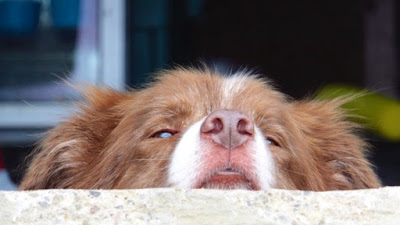 |
| Puffy - photo by Merry Leonard |
On a frigid December
morning, just as it is getting light, I spot the watcher. As usual the big bird
is perched near the top of a tall box elder tree along the southeastern edge of
our backyard. I’ve seen this bird almost every day in about the same location
for two winters now. Of course, it’s impossible for me to know if it’s always
the same bird. Nonetheless, I have reason to believe it is.
Identification of such a
large bird is easy even though I can only see its silhouette in the half-light
of dawn. It’s about the size of a chicken. It sits upright on the branch. It is
hefty but sleek, not pudgy enough to be an owl. Its tail is a prominent fan.
Even though I can’t see its powerful hooked bill I know it must be a red-tailed
hawk (Buteo jamaicensis). No other
native bird fits this description. It helps to know that the red-tail is the most common North American hawk.
As the sun rises I can see our
bird has a light, speckled breast with a dark band of feathers across the middle.
It wears a mottled dark brown overcoat. Pale sunlight filtering through its
broad tail reveals brick red feathers fading to muted orange. The bird watching
our yard is probably a female as it is quite large. We call her “Puffy.” Once
in a great while I see her noticeably smaller mate in the same tree. I have never
seen them both together.
I’ve thought a bit about why
Puffy choses to watch our yard in winter. I think the main reason is that the
box elder tree provides a perfect hawk perch. The tree is located at the edge of
a small wood on a steep hill. Given that a red-tail is able to see a mouse from
a long way away, our tree provides optimum hunting visibility.
We feed songbirds during the
winter but the frequent presence of our large red-tail does not seem to
particularly alarm the little brown birds. Maybe they know that 85% of this
hawk’s diet consists of rodents, especially mice and small squirrels. Red-tails
usually eat two or three mice a day. It’s an opportunistic feeder, however, and
will eat the occasional bird if necessary. So far as I can tell, most of the
songbird kills in our yard come from neighbors’ cats with only a very
occasional loss of a pigeon or cardinal to a passing Cooper’s or sharp-shinned
hawk.
Although
red-tailed hawks are often seen soaring, they are primarily perch-hunters. Elevated
perch sites are a necessary component of their habitat. According to the
Cornell Lab of Ornithology once a pair of red-tails finds a suitable home
territory they tend to stay in that territory for their entire lives. Red-tail
home territory can be as large as 25 square kilometers (about 10 square miles).
Red-tails are known to live for 25 years or more in the wild.
Red-tailed hawks
have adapted well to the human altered landscape. In recent years their
population has been slowly increasing. They especially like the small woodlots
in towns and villages. The interstate highway system has also created a prime
hunting area. Earlier this week Merry and I spotted seven red-tails within
sixty miles along the NYS Thruway (I-90).
I wonder if
there are more red-tails around in winter or whether I can just see them better
now that the leaves have fallen. The red-tailed hawk is a partial migrator.
This means some red-tails move south in winter and some do not. Many red-tails
from Canada and the northern US move just far enough south that snow does not
cover the trails of the mice that are their favored prey. Some individuals, especially older birds with established territories,
choose to stay put no matter how harsh the winter. I guess Puffy likes the weather
in Syracuse.
Puffy does not
stay in our tree all day long. She sits there motionless for an hour or two at
a time and then she is gone. I see her most often in the early morning, and then
again in the afternoon. For all I know she may sleep in our box elder.
During the
afternoon the crows let me know when Puffy returns to her perch. It’s called
mobbing. Even though adult crows are rarely killed by red-tails, crow chicks
make a convenient hawk snack. Crows never forget this. When they spot Puffy they
begin a continuous alarm call. This alerts other nearby crows that join the
raucous gang. Soon dozens of large black birds are perched all around Puffy
giving her all mighty hell. Eventually Puffy has enough and flies off pursued
by her cawing enemies, who swerve, zoom and dive at her.
Mobbing behavior
works because the red-tailed hawk relies on stealth to succeed in hunting. A
mob of noisy crows completely ruins this strategy so they leave to hunt
elsewhere. Of course, from the crow’s point of view, they simply want to drive the hawk a safe distance out
of their neighborhood. The mobbing crows are seldom at risk from Puffy’s deadly
talons, provided they keep her in sight and do not take too many foolish chances.
On this cold morning
I watched Puffy for ten minutes or so and found myself wondering what she could
be thinking. Indeed, do birds even think in a way we might be able to
understand? I took some deep breaths and let my mind relax. I stopped
controlling my thoughts. The sky was clear. Darkness slowly gave way to light that
tinted everything a pale golden yellow. Nothing moved. Then from left to right
the sky rippled with the black wings of dozens of crows. They passed in a few
seconds without taking any notice of the grand motionless hawk. A house wren
trilled. Winter.
References:
Hawk Mountain
Observatory at http://www.hawkmountain.org/raptorpedia/hawks-at-hawk-mountain/hawk-species-at-hawk-mountain/red-tailed-hawk/page.aspx?id=460





